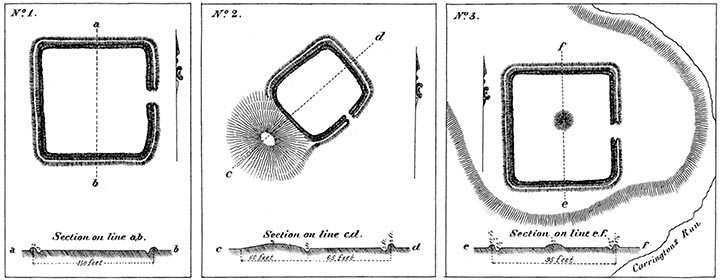PLATE VII. Nos. 1, 2, 3.
Figure No. 1, Plate VII., is situated in Lick Township, Jackson County, Ohio, on the west half of the north-east quarter of Sec. 19, T. 7, K. 18, on high ground; about one-fourth of a mile north-west of Salt Creek.The soil is clayey, the work slight, with only one opening which is on the east, and to my knowledge without running water in the vicinity. The ditch being interior, indicates that the work was built for some other purpose than defense, probably for ceremonial uses.
Figure No. 2, Plate VII., is on the same quarter section on the east half, and lies near the road from Jackson to Richmond, on the left hand. The prospect from this mound is extended and delightful. On the west, between this and No. 1, is a ravine and a small stream. As the soil is sandy, it is certain that the mound, attached to the rectangle on the south-west, was somewhat higher at first than it is at present.
Neither of these works is perfectly square or rectangular, but irregular in form, approaching a square.
No. 2 is clearly not a work of defense, and probably intended as a “high place" for superstitious rites. A more charming spot for such observances could not be chosen, if we admit that external circumstances and scenery had any connection with the sentiments of the worshippers; and we must allow that the mound- builders were alive to the beauty of scenery.
Sketch No. 3, is in Franklin township, Ross County, Ohio, on the land of Mr. George Johnson, about one mile west of the Scioto River. Entry No. 488. The soil is clayey, and the work is pleasantly situated, though the ground is not high.
The work is not more than half a mile from the rich bottom lands of the Scioto, which its builders probably cultivated.
A very large Pyrula perverse, about eight inches long, now in the State Cabinet at Columbus, was found near Mr. Johnson's house, about two feet below the surface, on the bottoms. There were two of them, which lay touching each other at the apex; the one in the cabinet being entire. This shell-fish is said to exist in the Gulf of Mexico, and on the coast of the Southern States; and has been found in many places at the West, in and about the ancient works. At Portsmouth, Ohio, six or seven were found buried in the soil, beneath the parallels of the great work described in the Smithsonian Contributions. They were at a depth of twenty-five feet in river alluvium. In Kentucky, the same shell has been frequently found, adjacent to old walls and mounds. They were probably used by the ancient race for religious and other ceremonies, as is said to be still the case among the Hindoos.


